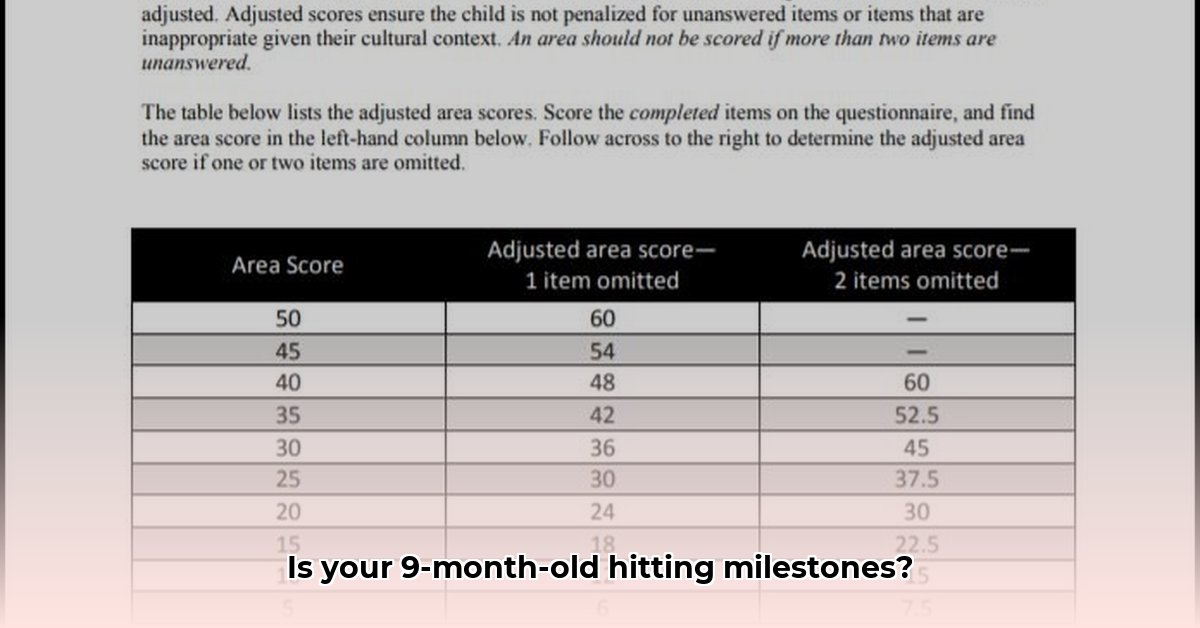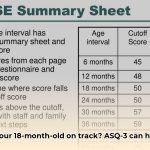Is your little one approaching nine months? It’s a thrilling time of tremendous growth! You’re likely eager to understand your baby’s developmental progress, and the ASQ-3 questionnaire can be a valuable tool. Think of it as a simple checklist to see how your baby is doing with communication, movement, problem-solving, and social interaction. This guide will walk you through the process, explain what the results mean, and provide fun ideas to help your baby flourish.
What the 9-Month ASQ-3 Checks
The ASQ-3 isn’t a pass-or-fail test; it’s a friendly check-in on your baby’s progress. You, the parent, complete the questionnaire to get a snapshot of your little one’s development. It captures milestones and highlights areas where they might benefit from extra support.
Five Key Areas Assessed
The 9-month ASQ-3 focuses on five key areas:
-
Communication: How your baby uses language and sounds. Do they babble, make varied sounds, or try to say words? Do they turn towards familiar voices? These skills form the basis for language acquisition.
-
Gross Motor Skills: Movements using large muscles. Can your baby roll, sit, crawl, or pull to stand? These milestones are vital for exploration and mobility.
-
Fine Motor Skills: Small muscle movements, especially in the hands. Can your baby pick up small objects between thumb and finger? Can they transfer toys between hands? These skills are important for eating, playing, and eventually, writing.
-
Problem Solving: How your baby figures things out. Do they explore toys by shaking, banging, or mouthing them? Do they understand cause and effect, like realizing that pushing a button makes a toy light up? These skills build a foundation for learning.
-
Personal-Social Skills: How your baby interacts with you and others. Do they smile, laugh, and show signs of independence, like playing alone briefly? These skills are crucial for building relationships.
Completing the ASQ-3: A Simple Guide
- Obtain the Questionnaire: Use the official ASQ-3 from Brookes Publishing to ensure you have the correct version.
- Find a Quiet Space: Choose a time and place with minimal distractions.
- Read the Instructions: Familiarize yourself with the questions and structure.
- Observe Your Baby: The questions ask about regular behaviors, not occasional ones.
- Answer Honestly: There are no right or wrong answers. Use “yes,” “sometimes,” and “not yet.”
- Score the Questionnaire: Follow the included instructions to calculate scores.
- Interpret the Results: Use the provided table to understand what the scores indicate.
Understanding Your Child’s ASQ-3 Scores
Scores are presented in relation to cutoff points.
| Score Range | Interpretation |
|---|---|
| Below Cutoff | This may suggest further observation or evaluation might be helpful. Discuss any concerns with your pediatrician. |
| At or Above Cutoff | This generally indicates that your child’s development is progressing typically. |
These scores are not a diagnosis but indicators to help you and your pediatrician understand your child’s development. Always consult your pediatrician with questions or concerns.
What If You Have Concerns?
If scores are below the cutoff, don’t panic. The ASQ-3 is a screening tool, highlighting areas where your child might benefit from additional support. Discuss the results with your pediatrician. They can provide further assessment and determine if early intervention services are appropriate.
Activities to Support Development
Boosting your baby’s development doesn’t require special equipment. Simple interactions are powerful:
Communication Boosters
- Talk, Talk, Talk: Narrate your day, sing songs, read books, and name objects.
- Back-and-Forth Babble: Respond to your baby’s coos and babbles as if having a conversation. Some studies suggest these early interactions strengthen language development.
Gross Motor Fun
- Tummy Time: Crucial for strengthening neck and back muscles.
- Sitting Practice: Help your baby practice sitting with support, then gradually reduce support.
- Crawling Encouragement: Create a safe space to explore crawling. Even pre-crawlers enjoy exploring different positions and movements.
Fine Motor Play
- Finger Foods: Offer soft, safe finger foods to encourage self-feeding and develop pincer grasp.
- Sensory Bins: Fill a container with safe, textured materials (like dry pasta, rice, or fabric scraps) for exploration.
- Stacking Toys: Blocks or cups encourage grasping, releasing, and hand-eye coordination.
Problem-Solving Playtime
- Hide-and-Seek: Peek-a-boo and hiding toys under blankets helps develop object permanence.
- Cause-and-Effect Toys: Toys with buttons, levers, and sounds teach about actions and reactions.
Social-Emotional Connections
- Face-to-Face Time: Engage in eye contact, smiles, and playful interactions.
- Social Games: Patty-cake and other interactive games encourage social skills.
Frequently Asked Questions (FAQs)
- Does the ASQ-3 replace pediatrician visits? No, it supports, but does not replace, checkups and discussions with your pediatrician.
- What if my baby was born prematurely? Adjustments can often be made to the ASQ-3 scoring for adjusted age. Consult your pediatrician.
- How do I find early intervention services? Your pediatrician can provide referrals. You can also contact your local health department or search online for local programs.
Nurturing Your Baby’s Development
Remember, every baby develops at their own pace. The ASQ-3 is one tool in your parenting journey. Celebrate your baby’s progress, recognize their strengths, and provide support where needed. By working with your pediatrician, you can nurture your little one’s growth and development. While existing research provides helpful information, ongoing studies continue to deepen our understanding of early childhood development. This article is intended for informational purposes only and does not constitute medical advice. Always consult with your pediatrician or other qualified healthcare professional for any concerns regarding your child’s health and development.
- Wind Energy Powered Cars: Are They the Future of Driving? - December 3, 2025
- Wind Energy in Cars: Is This the Future? - November 30, 2025
- Wind Energy For Residential: Is It Right For Your Home? - November 28, 2025
















